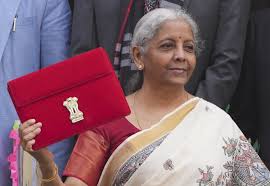Union Budget 2025-26: Tax Reforms and Key Proposals Summary
The government’s goal is to simplify taxation as part of its vision for a Developed India (Vikasith Bharat). A new Income Tax Bill will make the current tax laws easier to understand by reducing complexity, cutting both the chapters and words by half.
Key principles guiding these changes include good governance, reducing legal disputes, tax certainty, and responsive policymaking, with an emphasis on “Sabka Saath, Sabka Vikas” (Together with all, Development for all).
Tax Rate Structure Revisions
1. No Tax on Income Up to ₹12 Lakh
- Individuals earning up to ₹12 lakh annually (₹1 lakh per month) will pay no tax under the new regime.
- For salaried taxpayers, the ₹75,000 standard deduction increases this threshold to ₹12.75 lakh.
2. Revised Tax Slabs and Rates
- 0 – ₹4 lakh: 0%
- ₹4 – ₹8 lakh: 5%
- ₹8 – ₹12 lakh: 10%
- ₹12 – ₹16 lakh: 15%
- ₹16 – ₹20 lakh: 20%
- ₹20 – ₹24 lakh: 25%
- Above ₹24 lakh: 30%
3. Tax Rebates and Benefits
- Up to ₹12 lakh income (excluding special income like capital gains) will be eligible for a rebate, meaning no tax payable.
- Examples of benefits under the new tax regime:
- ₹12 lakh income: ₹80,000 tax benefit (100% reduction).
- ₹18 lakh income: ₹70,000 tax benefit (30% reduction).
- ₹25 lakh income: ₹1.1 lakh tax benefit (25% reduction).
These reforms aim to increase disposable income, boosting household consumption, savings, and investments.
4. Revenue Impact
- Estimated ₹1 lakh crore in direct taxes and ₹2,600 crore in indirect taxes will be foregone due to these proposals.
Other Major Tax Proposals
1. TDS and TCS Reforms
- Reduction in TDS rates and thresholds for simplicity.
- Increase in tax deduction limits:
- Senior citizens’ interest deduction limit raised from ₹50,000 to ₹1 lakh.
- TDS threshold for rent payments increased from ₹2.4 lakh to ₹6 lakh annually.
- TCS threshold for foreign remittances (under the RBI’s Liberalized Remittance Scheme) raised from ₹7 lakh to ₹10 lakh.
- TCS exemption for educational remittances funded by loans from specific financial institutions.
- Higher TDS provisions will apply only to non-PAN holders.
2. Voluntary Compliance and Updated Returns
- The time limit for filing updated returns is extended from 2 to 4 years.
- 90 lakh taxpayers voluntarily updated their incomes since the return facility was introduced in 2022.
3. Charitable Trusts and Compliance Relief
- The registration period for small charitable trusts extended from 5 to 10 years.
- New provisions to prevent disproportionate penalties for minor compliance errors.
4. Property and Transfer Pricing Reforms
- Taxpayers can now claim benefits for two self-occupied properties without conditions.
- 3-year block period for determining arm’s length pricing of international transactions.
- Safe harbor rules expanded to reduce litigation in international taxation.
5. Senior Citizen Benefits
- Exemption for withdrawals from National Savings Scheme (NSS) accounts with no interest accrual after August 29, 2024.
- Similar benefits extended to NPS (Vatsanya) accounts.
6. Digitalization and Dispute Resolution
- Paperless, digital tax orders and appeals will be implemented.
- Vivaat Se Vishwas dispute resolution scheme has helped 33,000 taxpayers settle disputes.
Measures for Investment and Employment Promotion
1. Presumptive Taxation for Non-Residents
- A new presumptive taxation scheme will apply to non-residents providing services to electronics manufacturing facilities in India.
2. Safe Harbor for Electronics Manufacturers
- Tax certainty will be provided for non-residents storing components for electronics manufacturing in India.
3. Tonnage Tax Extension
- Extension of the tonnage tax scheme to inland vessels registered under the Indian Vessels Act, 2021, to boost inland water transport.
4. Startup Ecosystem Support
- Benefits for startups will be extended to companies incorporated before April 1, 2030, for an additional five years.
5. IFSC Investment Incentives
- Specific benefits for ship leasing units, insurance offices, and treasury operations in the International Financial Services Centre (IFSC).
These proposals aim to simplify the tax structure, boost investments, and promote a more efficient and taxpayer-friendly system. The government is focused on supporting growth while making compliance easier for taxpayers across various sectors.
The Union Budget 2025 was presented by Finance Minister Nirmala Sitharaman on February 1, 2025. Here are some of the key highlights and updates from the budget:
1. Economic Growth and GDP Projections
- India’s GDP growth for FY2024-25 is projected at 6.5%, showing optimism despite global uncertainties.
- The fiscal deficit target for FY2024-25 has been set at 5.8% of GDP, continuing a path of fiscal consolidation.
2. Taxation and Reforms
- Personal Income Tax:
- The income tax slabs for individuals in the new tax regime have been revised to make it more progressive. The middle-income groups are expected to benefit significantly.
- The tax exemption limit for senior citizens has been increased to ₹3 lakh under the new regime.
- Corporate Tax:
- The corporate tax rate has been reduced for small and medium-sized businesses with turnover below ₹100 crore to 22%.
- Introduction of more tax incentives for businesses investing in research and development.
- GST Reforms:
- A proposal to rationalize GST rates for certain sectors.
- Digitization of GST filing is expected to become more streamlined, improving compliance and revenue collection.
3. Public Infrastructure and Capex
- The government has allocated an additional ₹15 lakh crore for infrastructure development under the National Infrastructure Pipeline (NIP), aimed at creating jobs and boosting the economy.
- Focus on urban mobility, smart cities, and rural roads, with major projects in transport and logistics aimed at improving connectivity.
4. Social Welfare and Health
- Allocation of ₹1.5 lakh crore for the Pradhan Mantri Jan Arogya Yojana (PMJAY), extending healthcare coverage to a larger section of the population.
- Enhanced provisions for women and children’s welfare programs, including more schemes for their empowerment.
5. Education and Skills
- ₹50,000 crore allocated to improve the quality of education, with a focus on increasing the availability of skilled workers through vocational training programs and upskilling initiatives.
- Expansion of digital learning platforms and the introduction of AI and robotics in education.
6. Green Economy and Sustainability
- The government has introduced a Green Growth initiative with a focus on sustainability, renewable energy, and reducing carbon emissions.
- Allocation of ₹75,000 crore towards promoting electric vehicles (EVs), solar energy projects, and sustainable farming practices.
7. Agriculture and Rural Development
- Increased budget for the PM-Kisan Scheme to benefit farmers, with additional financial support for irrigation projects and crop insurance.
- New programs to promote agri-tech innovations and organic farming.
8. Defense and National Security
- A ₹8.5 lakh crore defense budget, including increased funding for modernizing the military and procuring advanced technology.
- Focus on cybersecurity and defense R&D to strengthen national security.
9. Digital India and Technology
- The government has announced investments to further boost digital infrastructure under the Digital India program.
- Plans for creating a national digital public infrastructure to foster innovations in AI, blockchain, and other cutting-edge technologies.
10. Debt Management and Fiscal Responsibility
- India’s public debt management will continue to focus on maintaining fiscal responsibility while ensuring economic growth through investment in infrastructure and social sectors.
- Proposal to increase foreign direct investment (FDI) in select sectors.
These highlights are aimed at fostering economic growth, job creation, and enhancing social welfare, while also prioritizing green and digital transformation. The budget seeks to balance fiscal prudence with bold initiatives for sustainable development.

